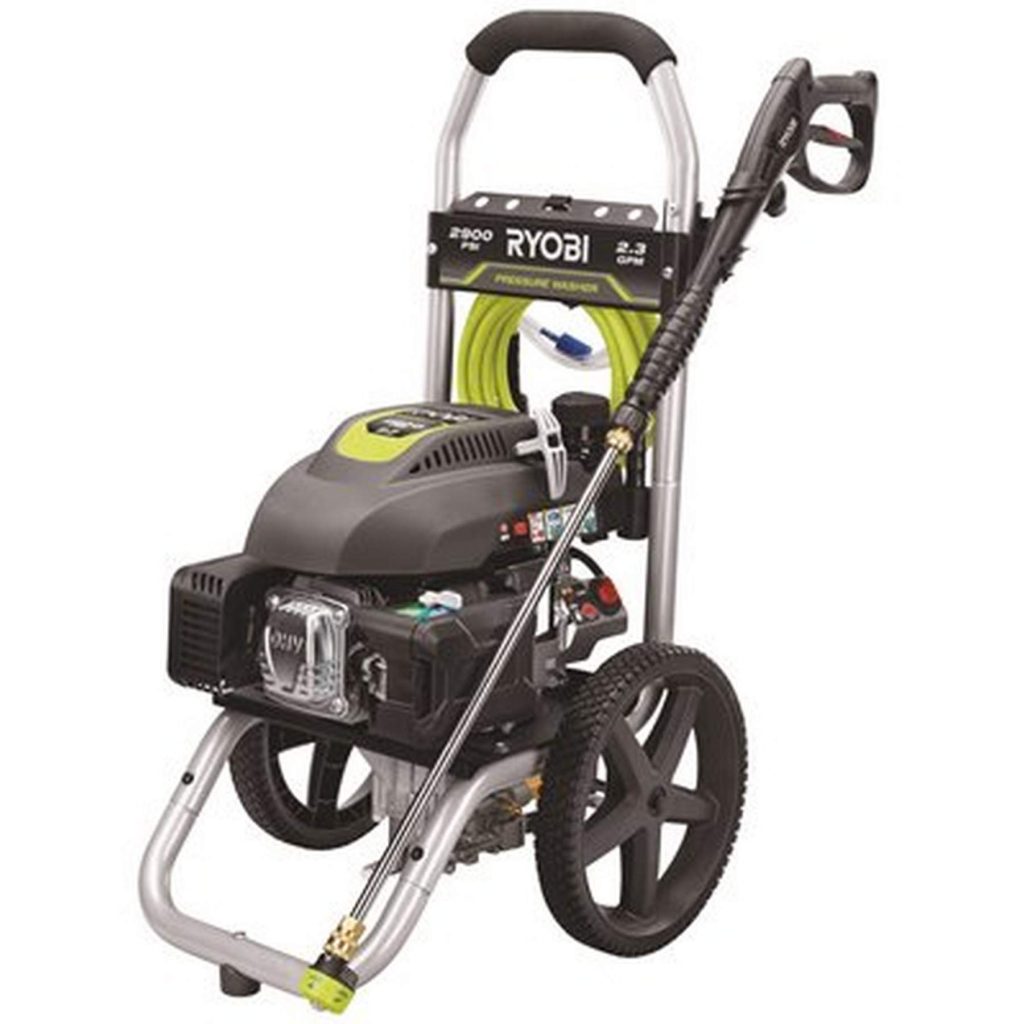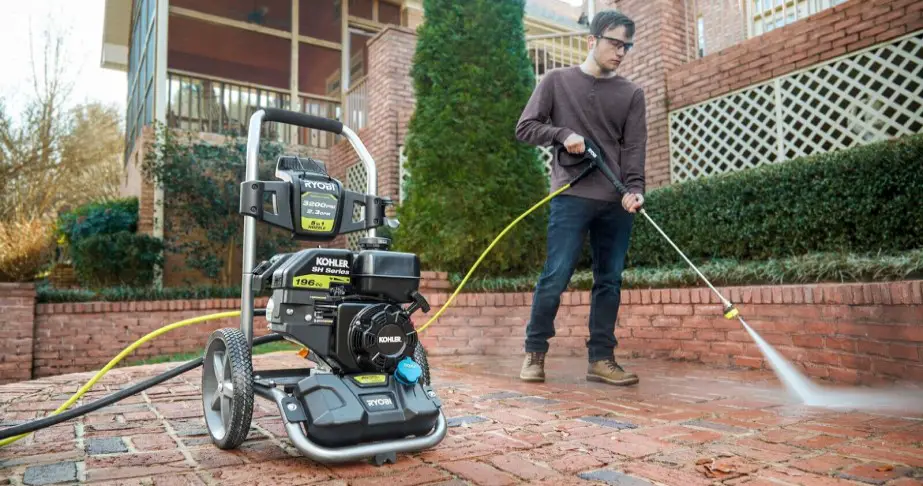Whether you’re a seasoned pressure washing enthusiast, a DIY aficionado, or a homeowner seeking to restore the luster of your outdoor spaces, understanding and adjusting PSI on your Ryobi pressure washer is an essential skill.
Like the conductor of an orchestra, the ability to fine-tune the water pressure allows you to wield the power of your pressure washer with precision and achieve optimal cleaning results.
From delicate surfaces to stubborn stains, adjusting PSI unlocks a world of possibilities, making your cleaning tasks a breeze.
A Quick Note on PSI
PSI refers to the amount of pressure generated by the water flow, measured in pounds per square inch.
It directly influences the cleaning effectiveness of your pressure washer.
Adjusting the PSI allows you to customize the water pressure according to the specific cleaning task at hand.
Can You Adjust PSI on Ryobi Pressure Washers?

Yes, you absolutely can adjust the PSI on Ryobi pressure washers.
The ability to fine-tune the water pressure is a valuable feature offered by many Ryobi models.
By adjusting the PSI, you can optimize the cleaning power for different surfaces and tasks, achieving outstanding results.
Related: Can You Use Motor Oil in a 4 Stroke Engine?
How to Adjust PSI on Your Ryobi Pressure Washer
To do this, let’s dive deeper into the step-by-step process.
Familiarize yourself with the control panel
Before adjusting the PSI, take a moment to familiarize yourself with the control panel of your Ryobi pressure washer.
The PSI adjustment knob or dial is typically located near the pump or on the pressure washer’s handle. It may be labeled as “PSI adjustment,” “Pressure adjustment,” or something similar.
Carefully inspect the control panel to identify the specific control for adjusting the PSI.
Locate the PSI adjustment control
Once you’ve identified the PSI adjustment control, take note of its position and how it operates.
Depending on your Ryobi model, the control may be a knob that you turn clockwise or counterclockwise, or it may be a dial that you rotate to increase or decrease the pressure.
It’s essential to understand the mechanism of the control before proceeding.
Turn the knob or dial
To adjust the PSI, turn the knob or dial in the appropriate direction.
If your control is a knob, rotating it clockwise typically increases the pressure, while rotating it counterclockwise decreases the pressure.
If you have a dial, turning it to a higher number usually increases the pressure while turning it to a lower number decreases the pressure.
Refer to the user manual specific to your Ryobi model for any additional instructions or guidelines regarding the PSI adjustment control.
Start with a lower PSI setting

When adjusting the PSI for the first time or when tackling a new cleaning task, it’s advisable to start with a lower PSI setting.
This allows you to gradually increase the pressure until you find the optimal level for the specific cleaning job.
Starting with a lower PSI helps prevent damage to delicate surfaces or materials.
Related: Types of Pressure Washer Unloader Valves
Gradually increase the PSI
Once you’ve set the pressure to a lower PSI, you can begin increasing it in small increments.
Turn the knob or dial slowly, allowing the pressure to adjust gradually. As you increase the PSI, pay attention to any changes in the water pressure and the sound of the pressure washer.
This will help you determine the appropriate pressure for the task at hand.
Test the pressure on a small area
Before applying the adjusted PSI to the entire surface, test it on a small, inconspicuous area.
Choose a spot that’s representative of the surface you’re cleaning. Activate the pressure washer and direct the spray onto the test area.
Observe the cleaning effectiveness and assess whether the pressure is too high or too low. Adjust the PSI accordingly based on the results.
Proceed to the entire surface
Once you’ve determined the optimal PSI through testing, you can confidently apply it to the entire surface you’re cleaning.
Maintain a consistent distance between the pressure washer nozzle and the surface for even and effective cleaning.
Factors to Consider When Adjusting PSI
Adjusting PSI isn’t a one-size-fits-all process.

Several factors should be taken into consideration to ensure effective and safe cleaning.
Here are some key factors to consider when adjusting PSI on your Ryobi pressure washer.
Cleaning Task Requirements
Different cleaning tasks, such as washing a car or removing tough stains from a concrete driveway, require varying levels of water pressure.
You consult the manufacturer’s recommendations or industry guidelines to determine the appropriate PSI range for your specific task.
Nozzle Types
The choice of the nozzle also affects the pressure output.
Nozzles with smaller orifices create higher pressure, while larger orifices result in lower pressure.
Experiment with different nozzle types to achieve the desired pressure for your cleaning job.
Safety Considerations
It’s essential to prioritize safety when adjusting PSI. High water pressure can cause damage to delicate surfaces or even pose a risk of injury.
Always wear appropriate protective gear and exercise caution when using higher PSI settings.
Related: Is 2000 PSI Good for a Pressure Washer?
3 Common PSI Adjustments for Cleaning Tasks
Now that we understand the factors involved in PSI adjustment, let’s explore some settings for different cleaning tasks.
Low PSI Settings
Use lower PSI settings (around 500-1000 PSI) for delicate surfaces such as vehicles, windows, or painted surfaces.
This prevents potential damage while still effectively removing dirt and grime.
Medium PSI Settings
For general cleaning tasks like sidewalks, fences, or decks, medium PSI settings (around 1500-2000 PSI) strike a good balance between cleaning power and surface safety.
High PSI Settings
When dealing with tough stains, heavily soiled driveways, or concrete surfaces, higher PSI settings (above 2000 PSI) are often required to achieve effective cleaning results.
PSI Adjustment Tips & Tricks
To make the most of your PSI adjustment capabilities, here are some best practices to keep in mind.
Test and Fine-Tune
Always test the pressure on a small, inconspicuous area before applying it to the entire surface. Fine-tune the PSI settings based on the desired cleaning outcome.
Maintain Proper Distance
Maintain a safe and optimal distance between the pressure washer nozzle and the surface being cleaned. This ensures even pressure distribution and reduces the risk of damage.
Use Detergents Wisely
Consider using compatible detergents to enhance the cleaning power of your pressure washer. Adjust the PSI accordingly when applying detergents to achieve the best results.
Related
- Best Time to Buy a Pressure Washer (Revealed)
- Ryobi Vs Craftsman Pressure Washers
- Best Pressure Washers Under $600
- How Does a Pressure Washer Unloader Valve Work? (Answered)
- Ryobi Vs Generac Pressure Washer (In-depth Reviews)
- Pressure Washing Pros and Cons
- Karcher Vs Ryobi Pressure Washers (Comparison)
- 10 Best Places to Buy Pressure Washers
- Ryobi Vs Simpson Pressure Washers (Final Verdict)
- Simpson Vs Craftsman Pressure Washers (Detailed Review)
- How to Unclog a Pressure Washer (Step-by-Step Guide)


